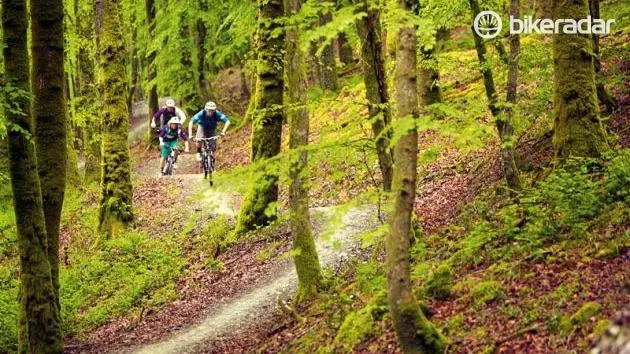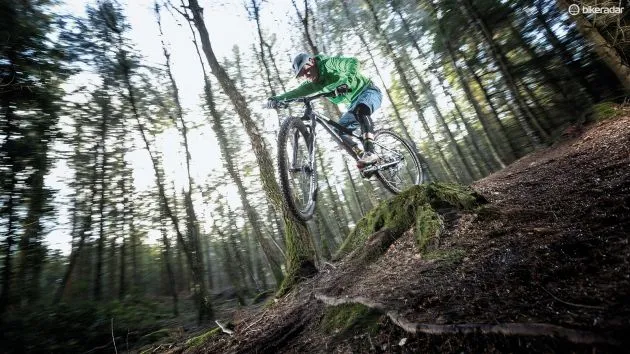Is it weird to have a favourite soil? I feel like it’s weird. I also feel like you have one too… assuming you’re a mountain biker, anyway. If you’re not, then it’s definitely weird and get out of my rhododendrons, you topsoil-sucking freak.
- 5 quick ways to get your mountain bike ready for a season of mud
- Clipping in: 5 mistakes I made so you don’t have to
- Motivation — who needs it?
I’m willing to bet your favourite soil is loam. Why? Because a soft and loose forest floor of loam is the Holy Grail of surfaces. It’s the ‘brown pow’ to equal the fresh snowpowder beloved of those who slide down mountains shouting ‘stoked’ and ‘sick’.
No but seriously, some of my best friends are snowboarders. It’s true! (It’s true in the modern sense, in that it’s not true but I’m shameless.)
Turns out it isn’t just mountain bikers who love loam. Loam is incredibly useful. Farmers are keen because it’s super-fertile and drains well, and is second only to clay for smearing all over the roads so that anyone on two wheels spears upside-down through the hawthorns whenever it rains. Then the farmer can charge £50 to drag you back through the hedge with the tractor. Never mind farming subsidies, loam is cash money.
No but seriously, some of my best friends are farmers.

Loam is also loved by builders. People have been building houses from loam for millennia — it’s actually one of the oldest construction methods there is. Mixed with straw or rice husks it makes great walls, while plastering it as a kind of thick, filthy wallpaper helps control humidity.
Essentially, entire aeons of planetary evolution have conspired to produce the most beautiful balance of grip and slip a mountain biker could desire
Nice. It might be a waste not to make a trail of it, but don’t imagine loam only creates mud huts. Take a look at the Great Mosque of Djenne in Mali which, with its ornate towers and vast spiky walls, is exactly what you were about to say.
What were you about to say? Certainly nothing funny, although people do have a good sense of humour about religious things. You were about to say this mosque is ‘one of the greatest achievements of the Sudano-Sahelian architectural style,’ partly because your riding buddies are always going on about it, and partly because that’s what it says on Wikipedia.
You weren’t about to say it looks like a model of the UK’s Houses of Parliament made by someone whose dogs have studded leather collars. Anyway, next time you have builders in, ask about loam. Most builders take so long to turn up they probably left when loam was the next big thing. They’ll be dead keen.
No but seriously, some of my best friends are builders.
So you can do amazing things with loam, but nothing so amazing as carving a trail through a steep, silent forest that feels both dead and alive at the same time. Loam is so fantastic because it’s the perfect mix of three things: sand, silt and clay.

Any of these on their own is poor for mountain biking, as you know. Though beautiful when dry, wet clay is grease, offering zero grip until you crash… at which point it sticks like superglue to a black hole. Note to self: maybe tyres made of clothes would stick? Second note to self: let someone else try first.
Silt, meanwhile (quartz and feldspar, finer than sand but coarser than clay) is slippery and turns easily to dust. If you’re riding on a lot of it you’ve probably fallen in a canal.
This is bad. What’s worse is that, beneath the black water and silty shopping trolleys and the stolen kids’ bikes and the driver in the Honda Civic still refusing to believe their GPS is wrong, you’ll find more clay.
Clays such as bentonite suck up water, but having rapidly waterlogged they actually become impervious. This makes clay ideal for lining canals — and bad for riding.
Finally, there’s sand. Sand is exhausting to ride on, is found next to hugely corrosive bodies of salty water and (after snow) is the leading cause of fat bikes. But hey! None of my friends have fat bikes, so there’s that.

Mix all these unpromising ingredients together and you get… if not black magic, then brown magic.
You get soil that’s crumbly, drains really well yet stays moist enough to hang together, and is great for growing things in. Things like trees, whose roots are both fun to ride and brilliant for binding slopes and stopping erosion. Loam is also rich in hummus, which is delicious with those big spicy crisps.
Wait. It’s rich in humus (one ’m’), which is a nitrogen-heavy soil created by decaying organic matter from plants, animals and anything else once-alive, such as your dreams of growing up to become an astronaut, or indeed your hopes of becoming anything that didn’t involve a suit or other uniform and the gravitational collapse of your soul every moonless night at 4am, say for instance something really great like Hollywood’s leading bicycle stuntman.
How did sand from the floor of the ocean get up in the hills? How was the silt deposited on such a steep, fast slope? This is the real magic, and proof that Mother Nature wants us to ride mountain bikes.
In truth it took millions of years of slow geological upheaval, the births and deaths of whole seas, and a lack of real commitment to disastrous global deforestation that’s only now being addressed by the world’s leading scum. It took all these things to collide to make the best trails.
Essentially, entire aeons of planetary evolution have conspired to produce — in favoured woods and forests, in softly hushed spots under an abyss of deep green trees — the most beautiful balance of grip and slip a mountain biker could desire.
How fantastic is that? And I’ve finally found some near my house! I know you’re happy for me. Obviously I’m not going to tell you where it is.
You get your own loam, yo.
